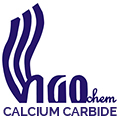Chemical characteristics of calcium carbide and its reaction with water
Calcium carbide is a chemical compound of calcium and carbon, and is a white crystalline substance when pure. It is obtained from the reaction
Calcium carbide has great practical significance. It is also known as calcium acetylide.
The chemical characteristics of calcium carbide
Calcium carbide is not volatile and not soluble in any known solvent, and reacts with water to yield acetylene gas and calcium hydroxide. Its density is 2.22 g/cm³. Its melting point is 2160 °C, and its boiling point is 2300 °C. Since the acetylene that forms upon contact with water is flammable, the substance is listed in hazard class 4.3.
Calcium acetylide was first obtained by German chemist Friedrich Wöhler in 1862 when he heated an alloy of zinc and calcium with coal. The scientist described the reaction of calcium carbide with water. Calcium carbide reacts vigorously with even mere traces of Н₂O, releasing a large amount of heat. If there is an insufficient quantity of water, the resulting acetylide spontaneously combusts. Calcium acetylide reacts violently with aqueous solutions of alkalis and diluted non-organic acids. These reactions release acetylide. With its strong reductive properties, CaC₂ reduces all metal oxides to pure metals or turns them into carbides.
It is easier to obtain calcium carbide from its oxide than from calcium itself, as the oxide is reduced at temperatures above 2000 °C. The metal and carbon combine:
CaO + 3C → CO↑ + CaC₂
The reaction takes place in an electric arc furnace, where a mixture of unslaked lime and coke or anthracite is heated. The technical product is grey due to the presence of free carbon, calcium oxide, phosphide, sulfide, and other chemical compounds. CaC₂ comprises 80-85% of the product by mass.
Use of calcium carbide
In the past, calcium carbide was used in carbide lamps, where it served as a source of acetylene flame. Nowadays these lamps are still used to power lighthouses and beacons, and also in cave exploration. CaC₂ also serves as a raw material in the development of chemical technologies, most notably synthetic rubber. Calcium carbide is also used to make vinyl chloride, acetylene black, acrylonitrile, acetic acid, acetone, ethylene, styrene, and synthetic resins.
Calcium carbide – reaction with water
When calcium carbide reacts with water, acetylene is released:
2H₂O + CaC₂ → C₂H₂↑ + Ca(OH)₂
Acetylene is an industrial substance with an unpleasant smell, which is caused by the impurities it contains (NH₃, H₂S, PH₃, and others). In its pure form, acetylene is a colorless gas with a characteristic faint smell, and it dissolves in water.

